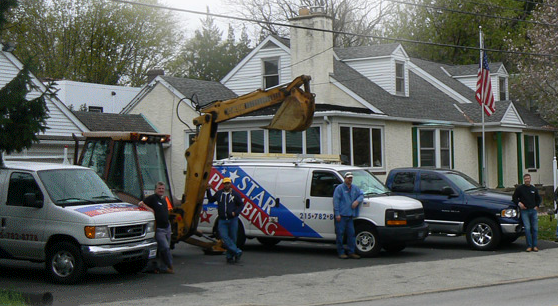What Is A Test Plug Used For? – A Comprehensive Guide
A test plug is a device used in a variety of applications to test the integrity of a pipe, conduit or other type of system. The plug is inserted into the system and sealed off with an airtight seal. A gauge is then connected to the plug, which allows for pressure testing or testing for leaks. Test plugs are used in many industries including plumbing, construction, industrial and automotive applications. They are also used in laboratories to conduct tests on samples or products. Test plugs provide an effective way of ensuring that systems remain safe and secure.
What Is a Test Plug?
A test plug is a specialized device used in plumbing to prevent leaks, detect blockages, and even conduct pressure tests. It is installed into the plumbing system via a pipe thread and can be quickly and easily removed when needed. Test plugs are made of either metal or plastic, depending on their purpose and the size of the pipe.
How It Works
Test plugs work by sealing off areas in the plumbing from any kind of water flow or pressure. This allows plumbers to test for blockages or leaks without having to shut down an entire system. When pressure is applied to the plug, it expands and presses firmly against the sides of the pipe, creating a secure seal that prevents water from escaping or entering.
Uses In Plumbing
Test plugs can be used for a variety of different purposes in plumbing systems. They are often used to detect blockages in pipes as well as to check for leaks which can help identify problems before they become more serious. They are also used to test pressure levels in pipes, which is important for ensuring that water flows at safe levels throughout the system.
Benefits of Using a Test Plug
Using a test plug offers several benefits for plumbers working on plumbing systems:
- Prevents Leaks: By sealing off areas of the plumbing system with a test plug, it helps prevent any kind of water leakage or seepage.
- Easy Installation and Removal: Test plugs are designed with easy installation and removal in mind, making them quick and simple to use.
Types of Test Plugs Available
Test plugs come in two main varieties: metal and plastic. Metal plugs are generally more durable than plastic plugs but may be more expensive due to their construction materials. Plastic plugs tend to be less expensive but may not last as long as metal ones do. The type chosen will depend on the size of the pipe being tested as well as what purpose it is being used for.
How To Choose A Test Plug For Your Plumbing?
When choosing a test plug for your plumbing system there are several factors that you should consider such as size, material type (metal vs plastic), cost, compatibility with existing pipes, ease of installation/removal, etc. It’s important to compare different specifications and options before making your selection in order to ensure that you get the most suitable one for your needs.
Installation and Maintenance Tips for Test Plugs
Installing a test plug is relatively straightforward but it’s important that it’s done correctly so that there are no leaks or other issues with your plumbing system.
Step by step guide:
- Measure Pipe Diameter – Measure out where you want your test plug installed using tape measure.
- Mark Location – Mark this location on both sides with either chalk or marker.
After installation it’s important to maintain your test plug properly so that it continues functioning correctly over time.
How To Care For Your Test Plug After Installation:
< liReplace O-ring – Replace O-ring if necessary after some time has passed.
< liClean Regularly – Clean off any dirt or debris from surface regularly using cloth or brush.
What Is A Test Plug Used For?
Test plugs are an essential tool for any plumbing project or maintenance job. They are designed to help identify and repair issues with the water supply lines, drain lines, and sewer lines. Test plugs are used to plug a pipe or fitting temporarily during maintenance or testing procedures. This helps prevent water or gas from entering the system during repairs or testing.
Common Uses for A Test Plug In Your Home or Business
Test plugs are primarily used to test water pressure in plumbing systems. They can be inserted into a pipe or fitting to block off the flow of water, allowing you to measure the pressure in the line. This is especially useful when trying to determine if a line is clogged, as it will allow you to determine if there is sufficient pressure in the line before attempting a more invasive repair.
Test plugs can also be used for troubleshooting other problems with the plumbing system. For instance, if you notice that your shower has low water pressure, you can insert a test plug into the shower head pipe and then turn on the hot and cold taps at full pressure. If the pressure returns to normal when both taps are open, then you know that something is blocking one of the pipes leading to your shower head.
In addition, test plugs can be used in irrigation systems and sprinkler systems to check for leaks in underground pipes and fittings. By inserting a test plug into a pipe or fitting and then checking for any loss of water pressure, you can quickly pinpoint where the leak is located so it can be repaired quickly and efficiently.
Different Ways You Can Use A Test Plug During Maintenance Projects
When performing regular maintenance on your plumbing system, it’s important that all pipes and fittings are checked regularly for signs of wear and tear as well as corrosion or other damage caused by age or extreme weather conditions. A test plug can be inserted into each pipe during maintenance so that no water flows through while repairs or replacements are being carried out. This helps ensure that no damage is caused to any parts of the system while repairs are being made.
In addition, test plugs can also be used during installation projects such as installing new faucets or replacing old fixtures with new ones. Inserting a test plug into each pipe before connecting them ensures that no leaks occur due to incorrect connections between pipes and fittings which could lead to costly damage down the line if left unchecked.
Finally, test plugs can also be useful when diagnosing potential problems with your plumbing system such as low-pressure issues or faulty valves which could lead to bigger problems if not identified early on in their development stages. By inserting a test plug into each affected part of your plumbing system while troubleshooting these kinds of issues, you can quickly pinpoint where any potential problems may lie without having to risk damaging any other parts of your plumbing system while doing so.
Possible Dangers Of Using A Test Plug Incorrectly
While using a test plug correctly provides many benefits for homeowners and businesses alike when it comes to maintaining their plumbing systems properly, using them incorrectly could pose serious risks both financially and safety-wise depending on how severe an error has been made while using one incorrectly . For example, inserting a test plug too far into a pipe could cause it become stuck inside permanently which would require professional assistance from either a plumber or technician in order to remove it safely without causing any additional damage . Not only would this cost time and money but it could also lead to costly repairs down the line if not addressed immediately . Furthermore , another possible danger associated with using a test plug incorrectly includes not letting enough air escape from behind it when first inserting one . If insufficient air escapes , this could cause significant backpressure within your pipes leading up potentially dangerous situations such as burst pipes which would require expensive repairs . As such , it’s important that anyone using one takes extra care when doing so in order ensure maximum safety at all times .
FAQ & Answers
Q: What is a test plug?
A: A test plug is a device designed to provide a seal in a pipe, hole, or other opening to block the flow of liquids and gases. It is usually made of rubber or plastic and can be used for both temporary and permanent sealing.
Q: How does a test plug work?
A: Test plugs work by creating an airtight seal when inserted into an opening. The plug has a rubber or plastic gasket that forms a seal against the walls of the opening, preventing liquids and gases from passing through.
Q: What are the benefits of using a test plug?
A: The main benefit of using a test plug is that it prevents leaks in plumbing systems. Additionally, they are easy to install and remove, making them ideal for temporary jobs or repairs.
Q: What types of test plugs are available?
A: Test plugs come in two main materials – metal and plastic. Metal plugs are usually more durable and provide better sealing capabilities than plastic plugs, but are also more expensive. Plastic plugs tend to be less expensive but may not provide as reliable of a seal.
Q: How do I choose the right test plug for my plumbing system?
A: When selecting a test plug for your plumbing system, you should consider several factors including size, material, type (temporary or permanent), cost and installation requirements. You should also compare different specifications and options before making your final selection.
A test plug is a useful tool for any plumber, as it enables them to temporarily seal off a section of pipe or drain. This gives the plumber the ability to check for and repair leaks without having to cut into the pipe or drain, saving time and money. Test plugs are also commonly used to seal off drains during maintenance work. In conclusion, test plugs are an essential part of plumbing, providing a fast and reliable way to seal off sections of pipe or drain for testing and maintenance purposes.
Author Profile

-
Star Plumbing, located in Elkins Park, PA, is a full-service plumbing company owned and operated by Mitchell Gordon. Since its inception, Star Plumbing has been providing its customers with reliable, quality plumbing services.
The Star Plumbing website offers informative articles on DIY plumbing and plumbing equipment, offering readers helpful advice and tips on how to take care of their own plumbing needs. This is a great resource for those who are looking to tackle a plumbing project themselves, as it provides useful information and advice on how to safely and successfully complete a plumbing job. Additionally, the website provides detailed descriptions of the various plumbing tools and equipment that are available, as well as detailed instructions on how to use them.
Star Plumbing’s website is a great resource for anyone with plumbing needs. Whether a customer is looking for advice on how to take care of their own plumbing or to schedule service from Star Plumbing, the website offers helpful advice and information for all their plumbing needs.
Latest entries
- April 12, 2024Plumbing Equipment And AccesoriesI Tested And Ranked The Best 10 Inch Rough In Round Toilet In 2024: And Here’s What I Found
- April 12, 2024Plumbing Equipment And AccesoriesI Tested And Ranked The Best Stone That Cleans Toilets In 2024: And Here’s What I Found
- April 12, 2024Plumbing Equipment And AccesoriesI Tested And Ranked The Best Heat Tape For Plumbing In 2024: And Here’s What I Found
- April 12, 2024Plumbing Equipment And AccesoriesI Tested And Ranked The Best Kaboom Toilet Bowl Tablets In 2024: And Here’s What I Found
